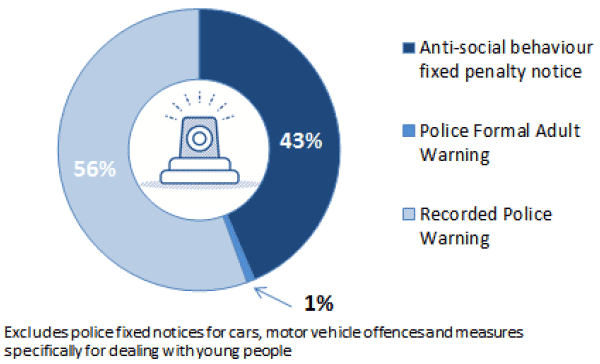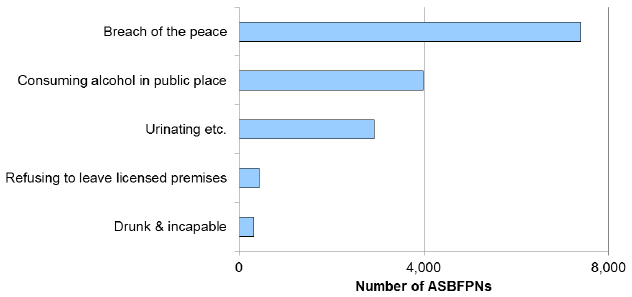Criminal proceedings in Scotland 2016-17: statistics
Statistics on criminal proceedings concluded in Scottish courts and alternatives to prosecution, issued by the police and by the Crown Office.
This document is part of a collection
15. Police Disposals
This section outlines detail on some of the measures available to the police for dealing with minor offences rather than referring individuals to the COPFS and therefore potentially to court. Statistics are presented on Anti-Social Behaviour Fixed Penalty Notices ( ASBFPNs), Recorded Police Warnings ( RPW) and actions used specifically for juveniles (aged 8 to 17) such as Restorative Justice Warnings and Early and Effective Interventions ( EEI). Formal Adult Warnings were phased out on the introduction of RPWs in January 2016.
At their peak, ASBFPNs accounted for around three quarters of the police disposals presented in this publication, but this has declined to 37% this year, the most used disposal in 2016-17 (47%) now being Recorded Police Warnings. It is important to note, however, that there are other types of police measures not included in these statistics such as fixed penalty notices for moving motor vehicle offences and other youth justice measures. A more detailed listing of the disposals available in this publication can be seen in Annex D.
Chart 14: Police disposals by type in 2016-17

Anti-Social Behaviour Fixed Penalty Notices
Anti-Social Behaviour Fixed Penalty Notices ( ASBFPNs) allow the police to issue offenders a £40 fine for a range of offences including drunken-related behaviours and playing loud music. In 2016-17, 15,363 people received an ASBFPN as a main penalty, a decrease of 48% from 29,368 in 2015-16. Levels have decreased sharply for the third year in a row after a period of relative stability between 2010-11 and 2013-14 (ranging between 53,674 to 55,562 ASBFPNs per annum). It is thought that some of the decline may be due to Police Scotland issuing revised guidance around the use of ASBFPN, and there may be some displacement by the use of Recorded Police Warnings.
Chart 15: Most common offences for Anti-Social Behaviour Fixed Penalty Notices ( ASBFPNs), 2016-17

In 2016-17 the vast majority of ASBFPNs were issued for three offence types:
- 7,397 for breach of the peace (48%); and
- 3,982 for consuming alcohol in a public place (26% of total);
- 2,921 for urinating etc. in circumstances causing annoyance to others (19%).
Males received 85% of all ASBFPNs in 2016-17 (12,986 people) with the most common offences being for breach of the peace, etc. (45% of ASBFPNs issued to males) followed by consuming alcohol in a public place (27%). ASBFPNs issued to females (2,376 people in total) were primarily issued for breach of the peace (66% of ASBFPNs to females) and consuming alcohol in a public place (21%).
Recorded Police Warnings and Formal Adult Warnings
The use of Recorded Police Warnings has grown quickly since being introduced in January 2016, becoming the most used police disposal in 2016-17. In the final quarter of 2015-16, 4,231 people (10%) received a recorded police warning as a main penalty. In 2016-17, the first full year of data since RPWs were introduced, 19,596 RPWs were issued, making up 47% of all police disposals in the year.
Formal Adult Warnings ( FAW) were phased out in January 2016 and, unsurprisingly, fell by 91% from 3,358 in 2015-16 to 316 in 2016-17. It is possible that cases relating to the small number of FAWs issued in 2016-17 may have commenced in previous years but were not closed until 2016-17. It is expected that the number of FAWs will be close to zero in the future.
Police disposals for children and young people involved in offending
This section provides statistics on some of the police disposals that specifically target children and young people, under the age of 18, involved in offending. The disposals we have information for are Early and Effective Interventions ( EEIs) and Restorative Justice Warnings as recorded on the Criminal History System ( CHS).
Please note that these statistics are not a full measure of disposals for under-18s as there are a number of other measures managed by the police and other public bodies that we cannot quantify levels for.
There are a number of routes for dealing with young people who have offended in Scotland as follows:
- Increasingly, the Whole System Approach ( WSA) is used to deal with young people aged 8 to 17. Following the preventing offending framework in 2008 and a WSA pilot in 2010, this approach was rolled out across Scotland in 2011 to encourage justice partners to channel young people away from the adult courts and hearing system. One approach used by the police to respond to the needs of children who offend is Early and Effective Intervention ( EEI). Early and Effective Intervention is a multi-agency response to low level offending, typically offences of a less serious nature, which might previously have automatically resulted in referral to the Children's Reporter. The EEI process runs differently in each Local Authority and the involvement of the police can be different in each Local Authority. For these reasons, the statistics presented here should be seen as a minimum indication of EEI activity.
- Other young people are referred to the Scottish Children's Reporter Administration ( SCRA), which manages the children's hearing system. This is a needs based system, including responding to occasions when children offend, rather than exposing them to the adult courts, which can be a damaging experience. The police can use a number of ways to refer individuals to SCRA such as restorative justice warnings, the disposal for which statistics are available. It is important to note that other organisations such as COPFS, social work and educational bodies can also make referrals to SCRA, though such referrals are not included in the statistics in this report, and can be found elsewhere [5] .
- Depending on their age and the nature of the offence some young people who have offended move through the Criminal Justice System in the same way as adults i.e. they are issued a disposal by the police, COPFS or the adult courts. This tends to happen for young people accused of more serious crimes with activity for these cases included within the statistics elsewhere in the report. No one under the age of 12 can be prosecuted in the adult courts in Scotland.
- The focus of EEIs is to respond as quickly as possible to offending behaviour by children and young people and to put in place appropriate support with the aim of reducing the likelihood of reoffending. Practices vary by local authority with a range of agencies (police, education, social work and the third sector) being involved.
Trends in Police Disposals for Young People
In terms of police disposals specifically aimed at young people involved in offending, Restorative Justice Warnings have been in decline from 2,457 people in 2008-09 to 280 people in 2016-17.
By contrast, the number of young people referred for EEI increased steadily since their introduction in 2008-09 rising to 2,588 people by 2011-12. In the three years between 2011-12 and 2015-16 numbers more than doubled to 6,587 people as the use of these practices became more commonplace. Between 2015-16 and 2016-17, numbers decreased by eight per cent from 6,587 to 6,090, although this follows a 26% increase between 2014-15 and 2015-16, so the latest figure remains higher than all but last year.
Contact
There is a problem
Thanks for your feedback